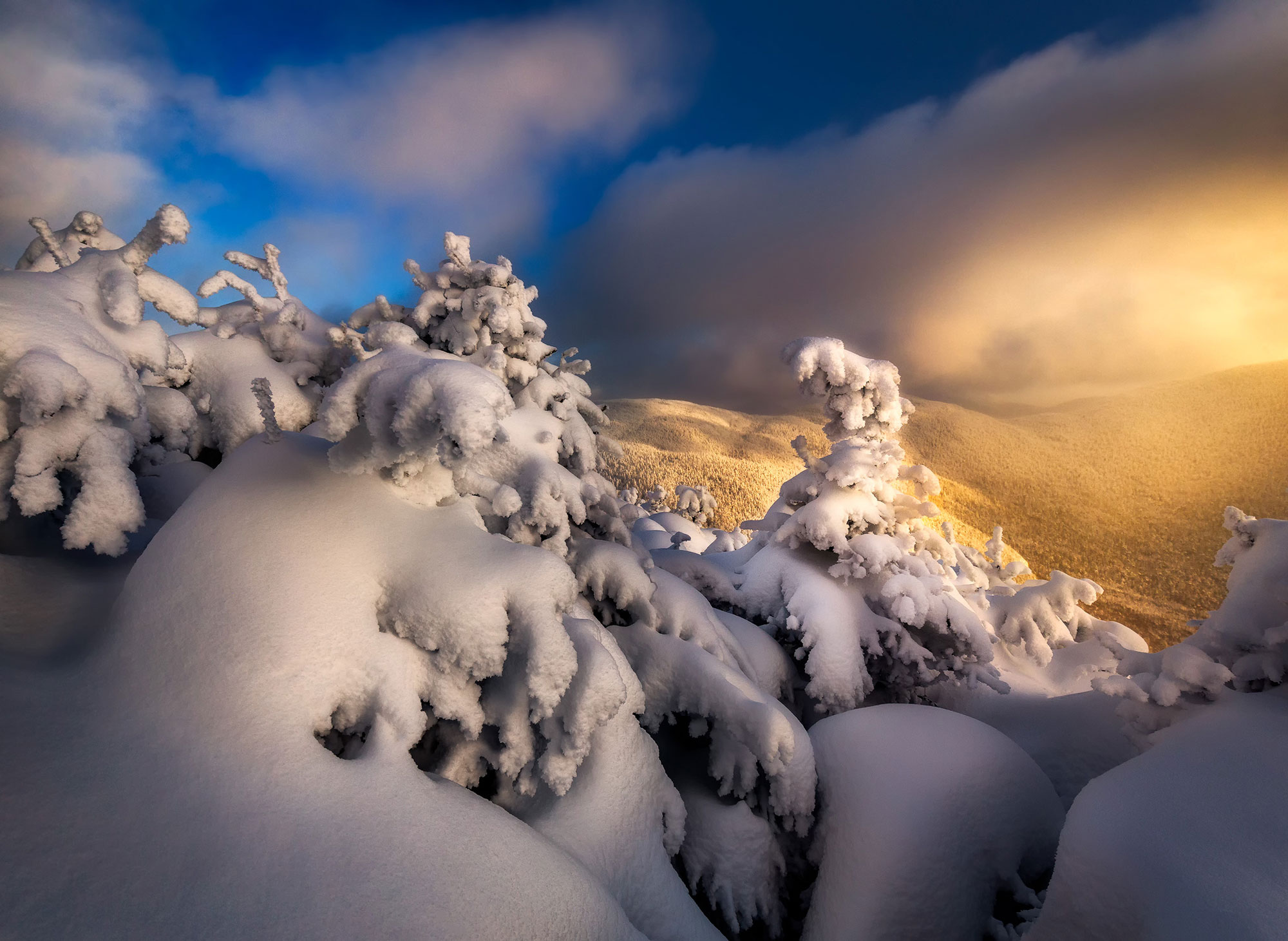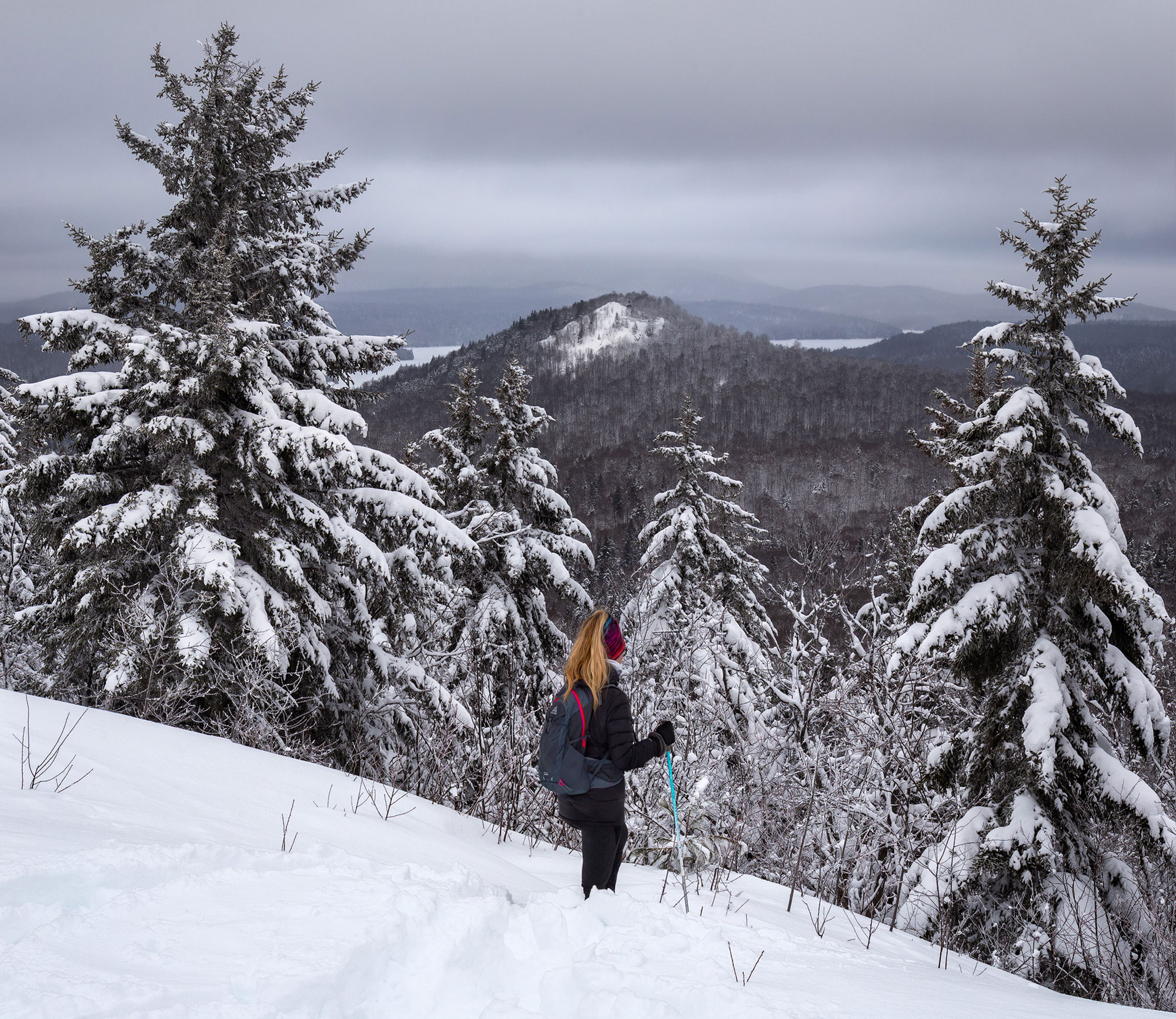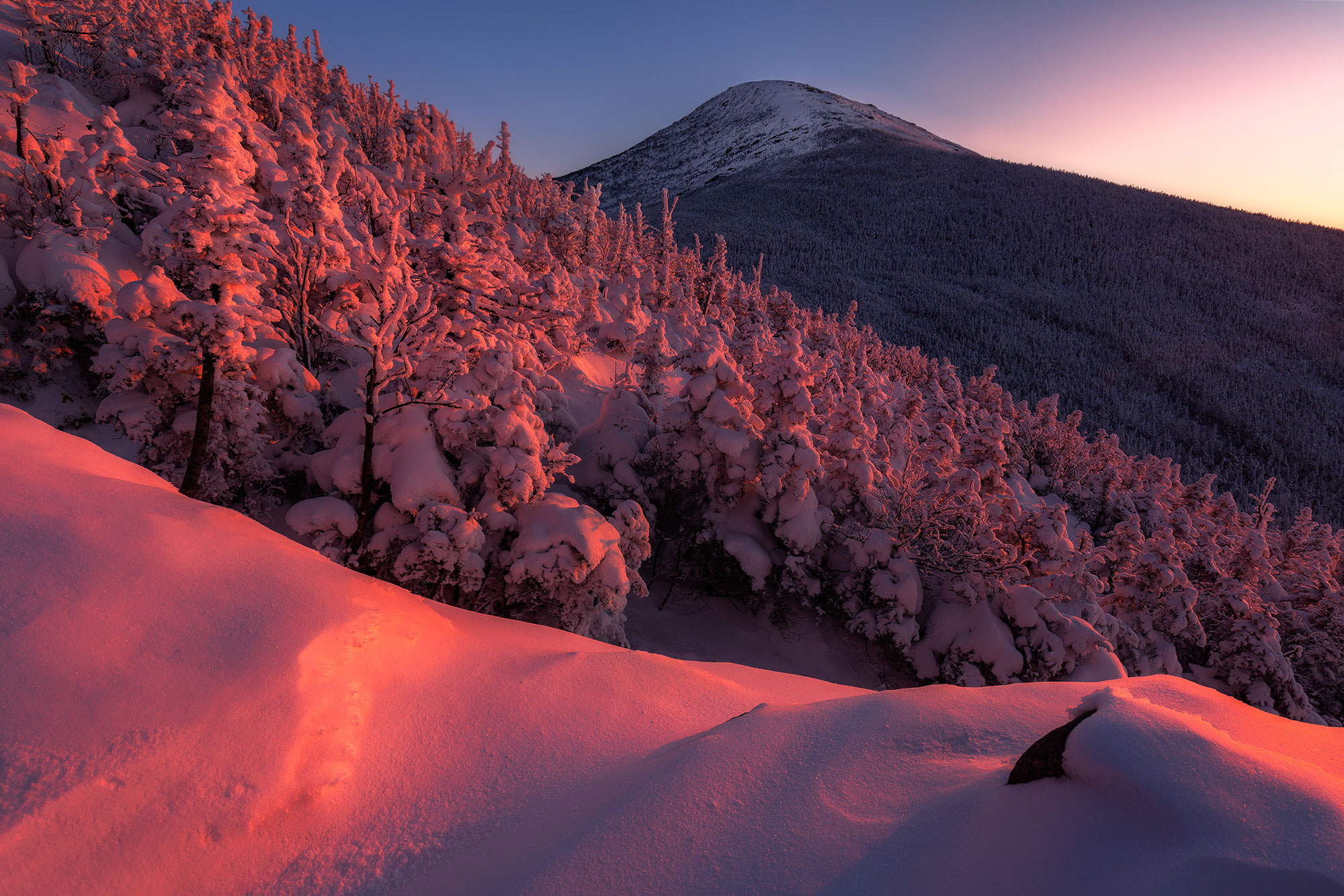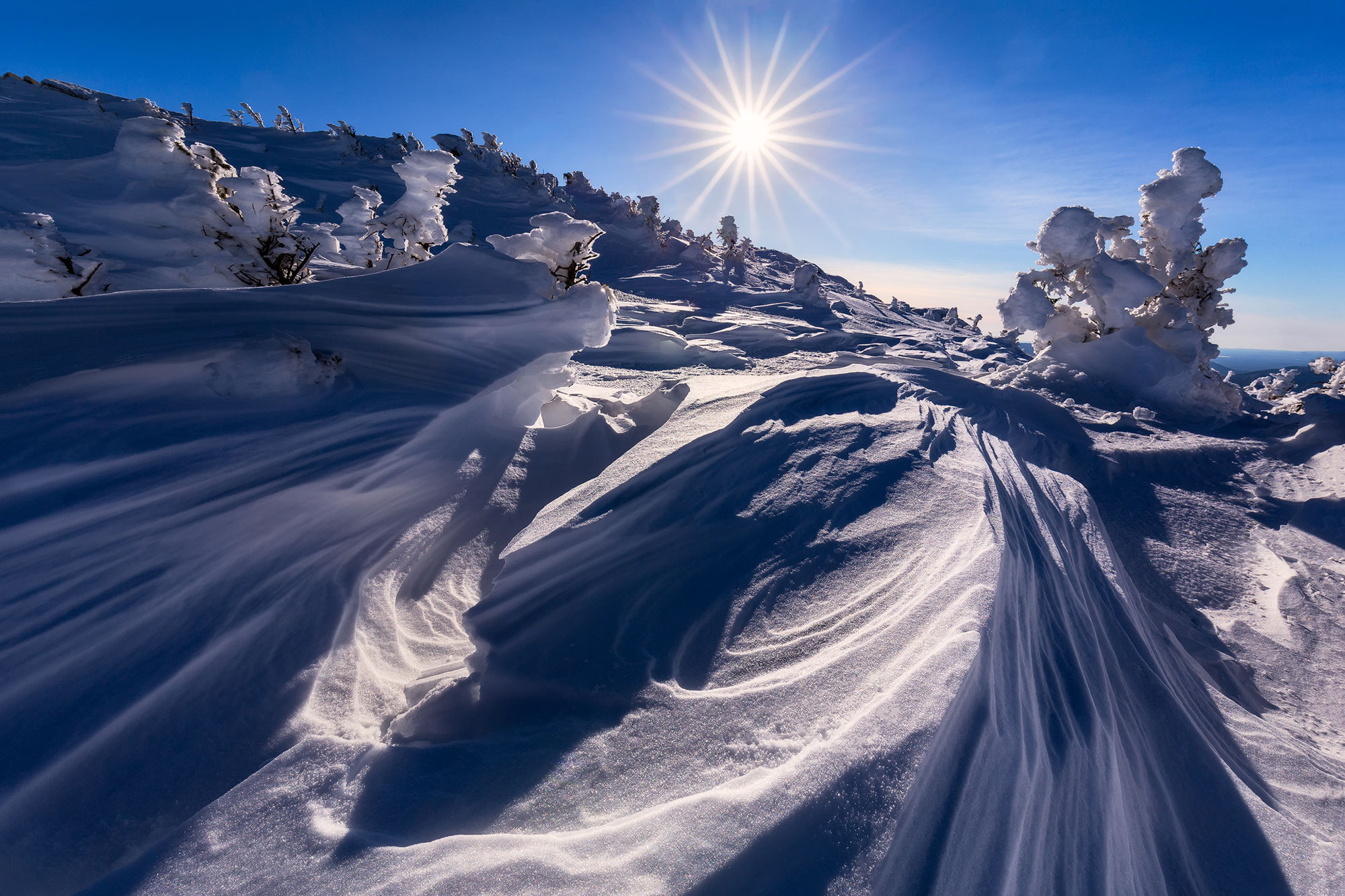Encompassing six million acres and possessing a myriad of mountains ranging in size from mile-high Mount Marcy to short and wooded summits, the Adirondacks has a mountain for every schedule and ability. Few outdoor experiences are more memorable or enjoyable than watching the sunset in solitude from a mountain summit, and the experience is made even more memorable with the extra challenges and solitude present in the winter season. With that in mind, here is a collection of Adirondack peaks that are all excellent winter sunset destinations.

Phelps Mountain
While not one of the tallest or the highest Adirondack High Peaks, Phelps Mountain is my personal favorite Adirondack peak for watching and photographing a winter sunset. Ringing in at a round-trip distance of 8.8 miles with almost 2,000 feet of elevation gain if departing from the Adirondack Loj (parking fee of $15/day, reduced to $7/day for Adirondack Mountain Club members), Phelps is in that sweet spot of providing enough of a challenge to make you feel like you’ve really accomplished something, while being short enough so that you won’t be hiking back in the dark for hours on end.
After a quick 2 mile jaunt to Marcy Dam and a little over a mile of gradual climbing along Phelps Brook, a classic steep and rugged Adirondack trail diverges from the Van Hoevenberg Trail to climb 1.2 miles to the summit of Phelps. Two characteristics of Phelps make this peak particularly amenable to winter sunsets. First, although the summit offers expansive views, it’s not completely exposed and hardy evergreens provide protection from the wind and make for interesting photo subjects when they’re caked with snow and ice. Second, Phelps offers wide-open views to the west, meaning that you’ll have a clear vantage point of the sun setting over the lofty summits of Mount Colden and Algonquin Peak, with Mount Marcy catching beautiful sidelight. While views from the summit proper are exceptional, ledges a couple hundred yards shy of the summit might provide an even better vantage point to watch the setting sun cast a warm glow on the snowy landscape.

Cascade Mountain
As one of the shortest and easiest of the 46 Adirondack High Peaks to climb, Cascade Mountain is a justly popular peak. While winter crowds are typically less than those found in summer and fall, the small parking lots on Rt. 73 can easily get overwhelmed on weekends. The late start that you’ll get to time it right to catch sunset from the summit typically makes this a moot point, but aim to do this one on a weekday if possible, just in case.
The vast majority of this hike is spent sheltered in the woods, and while the grade never gets too obnoxious, the climbing begins right from the parking lot and doesn’t let up much for the duration of the hike. A junction with the trail to Porter Mountain (another High Peak that’s often combined with a trek up Cascade) is reached at 2.1 miles, and then the final push to the exposed summit begins. Shortly after the trail junction is a good time to bundle up, as the wind is often much stronger on the exposed summit than the sheltered approach trail. Even though it only comes in as the 36th tallest peak in the High Peaks Region, Cascade offers a panoramic view that is likely a top 10 summit view in the Adirondacks.

Coney Mountain
With a round-trip distance of only 2.2 miles and an elevation gain of about 550 feet, Coney Mountain is one of the best bang-for-your-buck mountains in all of New York. Located off of Route 30 between Long Lake and Tupper Lake, Coney is a great destination to enjoy your first mountaintop winter sunset. A sheltered trail climbs gradually from the small parking lot through a beautiful forest before reaching the mostly open summit. Part of Tupper Lake can be seen in the distance and nearby Goodman Mountain (which itself is another good sunset hike) adds visual interest to the view. If the sky is clear and weather calm, hanging around after sunset to watch the stars is an incredibly rewarding experience, and the short distance back to the trailhead makes the return hike in the dark a breeze.

Mount Marcy
Standing as the highest mountain in New York at an elevation of 5,344 feet, Mount Marcy draws hikers from near and far. There’s just something about being at the highest point in a state that’s alluring, and from the icy winter summit of Marcy, all of the Adirondacks spreads out below your lofty perch. With a round-trip distance of nearly 15 miles coupled with over 3,000 feet of elevation gain, climbing Marcy makes for a long day, and catching the sunset from the summit means that you’ll have several hours of hiking in the dark back to the trailhead to look forward to. For those that have the requisite experience, fitness, and gear, though, it doesn’t get any better than this. After gradually ascending to treeline, the final half-mile push to the summit is on the wide-open and rocky summit block, with no protection from the elements. Once on the summit, a panoramic view of mountains and lakes spreads as far as the eye can see. As the sun sets over the distant horizon, take pride in the fact that no one in the state is higher than you, physically and maybe emotionally too, before readying for the long and dark sojourn home.

Algonquin and Wright Peaks
Two of the more popular High Peaks to climb, Algonquin and Wright are neighbors that share the same route for the first 3.4 miles from the Adirondack Loj and are thus often climbed in tandem. Coming in at round-trip distances of 7.6 (with 2,400 feet of elevation gain) and 8.6 (with 2900 feet of elevation gain) miles respectively, Wright and Algonquin are both classic Adirondack climbs that make for excellent sunset destinations. Both of these summits are quite exposed, though, which means expansive views but also little to no protection from the elements. It’s thus best to get some safer sunset summits under your belt before aiming for Wright or Algonquin.
From the Wright-Algonquin trail junction reached 3.4 miles from the Adirondack Loj parking lot, a left turns leads 0.4 miles to the summit of Wright. Views abound in all directions, with Whiteface and the ski jumps of Lake Placid in the distance to the north. The best part of Wright’s vantage point, though, is its proximity to the summit block of Algonquin, which towers above you and the seemingly endless procession of snow-covered evergreens that fill the divide between Wright and Algonquin. If the wind is howling, descending a bit from the summit to treeline provides a more sheltered, and possibly more interesting vantage point from which to watch the sunset over the shoulder of Algonquin and light up the flanks of Wright in brilliantly glowing sunset hues.
If at the aforementioned trail junction you’re feeling up for some added distance and elevation, rather than taking the side trail up to Wright continue on 0.9 miles to the exposed alpine summit of Algonquin. Views from the rocky tundra are unfettered and include Colden with its many slides and Trap Dike. Due to its entirely exposed nature, Algonquin is a peak best saved for a calm day. Spend some time exploring the summit before sunset (while being careful not to trample the rare and delicate alpine plants that make the summit home) and marvel at how the raking winds have sculpted the snow into fanciful shapes. As the second highest peak in the Adirondacks, Algonquin has a “top of the world” feel to it, and lingering on the summit and watching the sunset sky transition from orange to magenta to the deepest blue-black imaginable is an experience that could never be forgotten.

Joey Priola
Joey Priola is a scientist and wilderness photographer based out of Clifton Park, NY. He has a deep passion for exploring and photographing the wilderness, particularly the Adirondacks. While his love for the outdoors precedes his passion for photography, he now could not imagine having one without the other. Joey also greatly enjoys writing about his outdoor adventures, and one of the main goals he hopes to accomplish through his photography and stories is to inspire others to get outside and discover the same feelings of awe and wonder that the wilderness instills in him. More of his work can be found at his website and on Instagram.
Related Posts
April 12, 2024
Explore Like a Local: The Outdoor Mecca of North Conway, NH
There's a lot to love about this New…
April 3, 2024
5 Things To Do in the Boston Area During Mud Season
Adventure opportunities are abundant…




